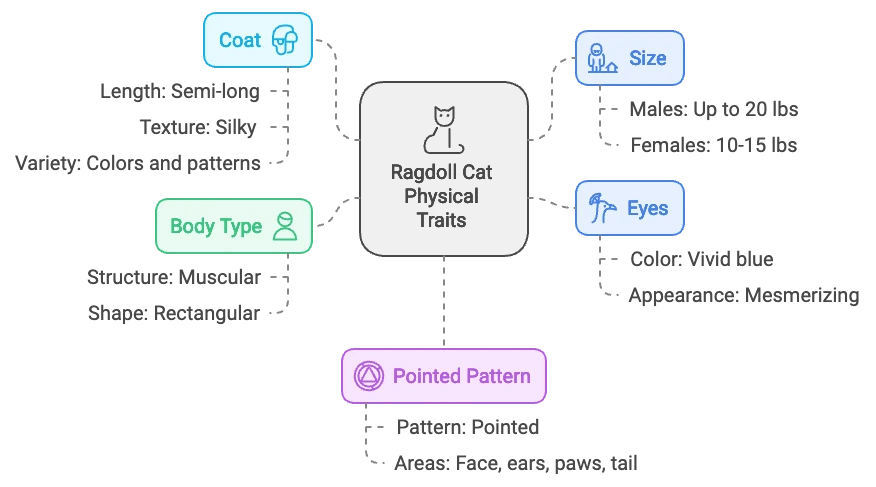Have you ever wondered what makes Ragdoll cats so special? These gentle giants of the feline world have captured the hearts of cat lovers everywhere with their striking blue eyes and silky soft fur. But there’s more to these adorable furballs than meets the eye. Let’s dive into the fascinating world of Ragdoll cats and discover why they’re such popular pets.
People know Ragdoll cats for their laid-back personalities and affectionate nature. They got their name from their tendency to relax and go limp when held, just like a ragdoll. This unique trait, combined with their stunning appearance, makes them a favorite among cat enthusiasts.
- Origins of the Ragdoll Cat
- Physical Characteristics
- Personality and Temperament
- Health and Lifespan
- Care and Maintenance
- Ragdoll Cats as Family Pets
- Ragdoll Cat Colors and Patterns
- Ragdoll Cats in Popular Culture
- Adopting a Ragdoll Cat
- Is Ragdoll a lazy cat ?
- Are Ragdolls expensive ?
- Conclusion
- Frequently Asked Questions
Origins of the Ragdoll Cat
The Ragdoll breed has an interesting history that dates back to the 1960s. Initially, a California-based cat breeder named Ann Baker developed this breed. To begin with, she started with a white Persian-like cat named Josephine, who had unique traits that Baker wanted to preserve.
Josephine’s kittens were exceptionally friendly and relaxed, which inspired Baker to selectively breed for these traits. As a result, over time, she developed the Ragdoll breed we know and love today. The breed gained recognition from major cat associations in the 1970s and since become one of the most popular cat breeds in the world.
Physical Characteristics
People know Ragdoll cats for their large size and striking appearance. Moreover, here are some key physical traits that set them apart:
- Size: Ragdolls are among the biggest types of cats that can be found in households. Males can weigh up to 20 pounds, while females typically range from 10 to 15 pounds.
- Coat: They have a semi-long, silky coat that comes in a variety of colors and patterns.
- Eyes: Perhaps their most distinctive feature, Ragdolls have vivid blue eyes that are almost mesmerizing.
- Body Type: They have a muscular, rectangular body with a plush coat that makes them look even larger.
- Pointed Pattern: Like Siamese cats, Ragdolls have a pointed color pattern, meaning their faces, ears, paws, and tails are darker than the rest of their body.

One of the most endearing features of Ragdoll cats is their soft, plush coat. People often describe it as feeling like rabbit fur, making them irresistibly cuddly. Despite their long hair, Ragdolls don’t require as much grooming as some other long-haired breeds. Their coat doesn’t mat easily, but experts still recommend regular brushing to keep it in top condition.
Personality and Temperament
Ragdoll cats are famous for their docile and affectionate nature. They’re often described as “puppy-like” due to their tendency to follow their owners around the house and their love of being close to their human companions. Below are several important characteristics that define Ragdoll cats:
- Gentle: Ragdolls are known for their calm and gentle demeanor. They rarely use their claws and are patient with children and other pets.
- Affectionate: These cats love to be near their owners and often seek out cuddles and attention.
- Relaxed: True to their name, Ragdolls are very relaxed cats. They’re content to lounge around the house and don’t require as much activity as some other breeds.
- Intelligent: Despite their laid-back nature, Ragdolls are quite smart and can learn tricks and commands.
- Social: Ragdoll cats don’t like to be alone; they enjoy the company of humans and other pets.
One of the most endearing traits of Ragdoll cats is their tendency to flop into their owner’s arms when picked up. This relaxed behavior is where they get their name, and it’s a characteristic that many Ragdoll owners find irresistible.
Health and Lifespan
Ragdoll cats are generally healthy, but like all purebred cats, they can be prone to certain genetic health issues. Some potential health concerns for Ragdolls include:
- Hypertrophic Cardiomyopathy (HCM): This is a form of heart disease that can affect Ragdolls.
- Bladder Stones: Some Ragdolls may be prone to developing bladder stones.
- Dental Issues: Like many cats, Ragdolls can develop dental problems if people don’t properly care for their teeth.
Despite these potential health issues, Ragdolls are known for their longevity. With proper care, Ragdoll cats can live anywhere from 12 to 17 years, with some even reaching their early 20s. In addition, regular vet check-ups, a balanced diet, and plenty of love and attention can help ensure your Ragdoll lives a long and healthy life.
Care and Maintenance
Caring for a Ragdoll cat isn’t particularly challenging, but there are some specific needs to keep in mind:
Grooming: While Ragdolls don’t mat as easily as some long-haired breeds, they still benefit from regular grooming. Brushing your Ragdoll cat 2-3 times a week will help keep their coat in good condition and reduce shedding.
Diet: Just like any other cat, Ragdolls require a well-rounded diet that is high in protein. Because of their size, larger cat breeds may need a greater amount of food compared to smaller ones. Make sure to always seek advice from your veterinarian regarding the most suitable diet for your Ragdoll cat.
Exercise: Despite their relaxed nature, Ragdolls still need exercise to stay healthy. Interactive toys and play sessions can help keep them active and maintain a healthy weight.
Mental Stimulation: Ragdolls are intelligent cats that enjoy puzzle toys and learning new tricks. Therefore, providing mental stimulation can help prevent boredom and associated behavioral issues.
Litter Box: Due to their large size, Ragdolls may need a larger litter box than average. Make sure to keep it clean, as Ragdolls can be particular about their bathroom habits.
Remember, every cat is an individual, and your Ragdoll cat may have specific needs or preferences. Consequently, paying attention to your cat’s behavior and consulting with your vet can help you provide the best care possible.
Ragdoll Cats as Family Pets
Ragdoll cats are fantastic for families because of their gentle and loving personality. Known for their ability to interact well with both children and other animals, they are a great choice for homes with multiple pets. Here are a few explanations for why Ragdolls make great family friends :
- Patient with Children: People recognize Ragdolls for their ability to tolerate and be patient, which makes them well-suited for families with children.
- Get Along with Other Pets: Their easy-going nature means they often get along well with other cats and even dogs.
- Adaptable: Ragdolls can adapt to various living situations, from small apartments to large houses.
- Low Noise Level: Unlike some cat breeds, Ragdolls are not particularly vocal, making them good pets for those who prefer a quieter home.
- Affectionate: Their love for human companionship means they’ll often be right by your side, offering comfort and cuddles.
While Ragdolls are great family pets, it’s important to teach children how to properly handle and respect these gentle giants. Despite their relaxed nature, Ragdolls should always be treated with care and gentleness.
Ragdoll Cat Colors and Patterns
One of the most fascinating aspects of Ragdoll cats is the variety of colors and patterns they come in. Here’s a breakdown of the different color and pattern combinations you might see:
Colors:
- Seal
- Blue
- Chocolate
- Lilac
- Red
- Cream
Patterns:
- Colorpoint: The body is lighter, with points (face, ears, paws, and tail) in a darker shade.
- Mitted: Like colorpoint, but with white markings on the paws and sometimes a white chin.
- Bicolor: The body is mostly white with colored points and a distinctive “V” shape on the face.
You can mix and match these colors and patterns, resulting in a wide array of beautiful combinations. For example, you might have a seal mitted Ragdoll or a blue bicolor Ragdoll. This variety means that no two Ragdolls look exactly alike, adding to their charm and appeal.
Ragdoll Cats in Popular Culture
Ragdoll cats have made their mark in popular culture, appearing in various forms of media and gaining celebrity fans. Here are a few interesting facts about Ragdolls in pop culture:
- Taylor Swift’s Ragdolls: People know the pop star for her love of cats, including her Ragdolls, Olivia Benson and Meredith Grey.
- Internet Famous: Many Ragdoll cats have gained fame on social media platforms like Instagram and TikTok, showcasing their adorable antics and stunning looks.
- Advertising: The breed’s striking appearance has made them popular choices for cat food and product advertisements.
- Children’s Books: Ragdoll cats have been featured in several children’s books, often portrayed as gentle and loving companions.
The popularity of Ragdolls in media and among celebrities has contributed to the breed’s growing popularity among cat enthusiasts worldwide.
Adopting a Ragdoll Cat

If you’re considering adding a Ragdoll cat to your family, there are several routes you can take:
Breeders: Reputable breeders can provide purebred Ragdoll kittens. Make sure to research and select a breeder who values the health and welfare of their cats.
Rescue Organizations: There are rescue organizations specifically dedicated to Ragdoll cats. Rescuing a cat can be an excellent way to provide a home for a feline in need.
Animal Shelters: While less common, Ragdolls can sometimes be found in general animal shelters.
When adopting a Ragdoll, consider the following:
- Space: Ragdolls are large cats and need enough space to move around comfortably.
- Time: These cats thrive on human interaction and may not be suitable for those who are away from home for long periods.
- Cost: As with any pet, consider the ongoing costs of food, veterinary care, and supplies.
- Commitment: Ragdolls can live up to 17 years or more, so be prepared for a long-term commitment.
Remember, adopting a cat is a big decision. Take your time, do your research, and make sure a Ragdoll is the right fit for your lifestyle and family situation.
Is Ragdoll a lazy cat ?
Ragdoll cats are often perceived as lazy due to their laid-back and relaxed nature, but this characterization can be misleading. While they do enjoy lounging and can spend a significant amount of time resting, Ragdolls are not entirely inactive. They require regular playtime—around 15-20 minutes several times a day—to keep them mentally and physically engaged. Interactive toys, such as feather wands and laser pointers, are ideal for stimulating their playful instincts. Ragdolls are moderately energetic and enjoy social interaction, which means they thrive on playtime with their owners. Therefore, while they may seem lazy at times, Ragdolls benefit from structured play sessions that cater to their playful side and help maintain their overall health.
Are Ragdolls expensive ?

Ragdoll cats can be quite expensive, with prices typically ranging from $800 to $2,500 depending on various factors. The cost is influenced by the cat’s pedigree, color, and whether it is a pet or show quality. For example, pet-quality Ragdolls may start around $800, while show-quality cats can exceed $2,000. Additionally, the reputation of the breeder plays a significant role in pricing; reputable breeders often charge more due to their commitment to health and breed standards.Beyond the initial purchase price, potential owners should also consider ongoing expenses such as food, grooming, veterinary care, and supplies. Monthly costs can range from $265 to $750, depending on factors like diet and healthcare needs. Overall, while Ragdolls are a significant financial investment, many owners find their affectionate nature and unique personalities make them worth the cost.
Conclusion
Ragdoll cats are truly special creatures. With their striking appearance, gentle temperament, and affectionate nature, it’s no wonder they’ve become one of the most popular cat breeds in the world. Whether you’re drawn to their beautiful blue eyes, soft fur, or puppy-like personality, Ragdolls have a lot to offer as companions.
From their interesting origin story to their variety of colors and patterns, Ragdolls are as fascinating as they are adorable. Their adaptability makes them suitable for various living situations, and their gentle nature makes them excellent family pets.
However, like any pet, Ragdolls require proper care, attention, and love. They thrive on human interaction and may not be the best choice for those who are away from home frequently. But for those who can provide the care and attention they need, Ragdolls offer a unique and rewarding pet ownership experience.
Whether you’re a long-time cat lover or considering getting your first feline friend, a Ragdoll cat could be the perfect addition to your family. Their combination of beauty, intelligence, and affection makes them truly special companions that can bring joy and love to any home.
Frequently Asked Questions
To identify a Ragdoll cat, look for these key characteristics:
Size: Ragdolls are large cats, with males typically weighing between 12 to 20 pounds and females ranging from 8 to 15 pounds.
Coat: They have a semi-long to long, plush coat that is soft and silky. Common colors include seal, blue, chocolate, lilac, and cream, with patterns such as colorpoint, mitted, and bicolor.
Eye Color: Ragdolls are known for their striking blue eyes.
Body Structure: They have a sturdy, long-bodied build with a broad head and a long tail. A fatty pad on the lower abdomen is also common.
Temperament: Ragdolls are gentle and affectionate, often going limp when held. They are social and enjoy interacting with humans and other pets.
Playfulness: While they love to lounge, Ragdolls require regular playtime to stay engaged and healthy.
No, Ragdoll cats are not hypoallergenic. While they produce less of the protein that causes allergies compared to some other breeds, they can still trigger allergic reactions in sensitive individuals.
Ragdolls have a semi-long coat that does shed, especially during seasonal changes. Frequent grooming can aid in controlling excessive shedding and maintaining the quality of their fur.
Ragdolls are best suited as indoor cats. Their trusting nature and lack of strong survival instincts can make them vulnerable outdoors.
Ragdolls are among the bigger breeds of domestic cats. Males can weigh up to 20 pounds, while females typically range from 10 to 15 pounds.
Yes, Ragdolls are known for their easy-going nature and often get along well with dogs, especially when introduced properly and at a young age.
Ragdoll cats are special for their affectionate nature, playful yet laid-back demeanor, and sociable behavior, making them excellent companions for families. With their striking blue eyes and silky coats, they are one of the largest domestic cat breeds, known for their unique tendency to go limp when held. Despite their long fur, Ragdolls require minimal grooming and are intelligent enough to learn tricks and commands. While generally healthy, they can be prone to certain genetic conditions, so regular vet check-ups are essential. Overall, Ragdolls combine beauty, charm, and a loving personality, making them cherished family members.


